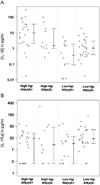Mercury exposure, serum antinuclear/antinucleolar antibodies, and serum cytokine levels in mining populations in Amazonian Brazil: a cross-sectional study
- PMID: 20176347
- PMCID: PMC2873228
- DOI: 10.1016/j.envres.2010.02.001
Mercury exposure, serum antinuclear/antinucleolar antibodies, and serum cytokine levels in mining populations in Amazonian Brazil: a cross-sectional study
Abstract
Mercury is an immunotoxic substance that has been shown to induce autoimmune disease in rodent models, characterized by lymphoproliferation, overproduction of immunoglobulin (IgG and IgE), and high circulating levels of auto-antibodies directed at antigens located in the nucleus (antinuclear auto-antibodies, or ANA) or the nucleolus (antinucleolar auto-antibodies, or ANoA). We have reported elevated levels of ANA and ANoA in human populations exposed to mercury in artisanal gold mining, though other confounding variables that may also modulate ANA/ANoA levels were not well controlled. The goal of this study is to specifically test whether occupational and environmental conditions (other than mercury exposure) that are associated with artisanal gold mining affect the prevalence of markers of autoimmune dysfunction. We measured ANA, ANoA, and cytokine concentrations in serum and compared results from mercury-exposed artisanal gold miners to those from diamond and emerald miners working under similar conditions and with similar socio-economic status and risks of infectious disease. Mercury-exposed gold miners had higher prevalence of detectable ANA and ANoA and higher titers of ANA and ANoA as compared to diamond and emerald miners with no occupational mercury exposure. Also, mercury-exposed gold miners with detectable ANA or ANoA in serum had significantly higher concentrations of pro-inflammatory cytokines IL-1beta, TNF-alpha, and IFN-gamma in serum as compared to the diamond and emerald miners. This study provides further evidence that mercury exposure may lead to autoimmune dysfunction and systemic inflammation in affected populations.
Copyright 2010 Elsevier Inc. All rights reserved.
Figures






Comment in
-
Auto-antibodies to nuclear and nucleolar antigen and long-term exposure to inorganic mercury.Environ Res. 2010 Nov;110(8):821. doi: 10.1016/j.envres.2010.08.001. Epub 2010 Aug 24. Environ Res. 2010. PMID: 20797701 No abstract available.
References
-
- Abedi-Valugerdi M, Moller G. Contribution of H-2 and non-H-2 genes in the control of mercury-induced autoimmunity. Int Immunol. 2000;12:1425–1430. - PubMed
-
- Aks SE, et al. Fractional mercury levels in Brazilian gold refiners and miners. J Toxicol Clin Toxicol. 1995;33:1–10. - PubMed
-
- Alves MF, et al. Fish consumption, mercury exposure and serum antinuclear antibody in Amazonians. Int J Environ Health Res. 2006;16:255–262. - PubMed
-
- Apostolakis S, et al. IL-1 cytokines in cardiovascular disease: diagnostic, prognostic and therapeutic implications. Cardiovasc Hematol Agents Med Chem. 2008;6:150–158. - PubMed
-
- Appleton JD, et al. Impacts of mercury contaminated mining waste on soil quality, crops, bivalves, and fish in the Naboc River area, Mindanao, Philippines. Sci Total Environ. 2006;354:198–211. - PubMed
Publication types
MeSH terms
Substances
Grants and funding
LinkOut - more resources
Full Text Sources
Medical

